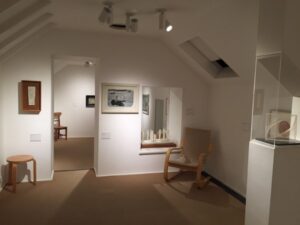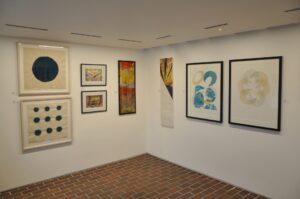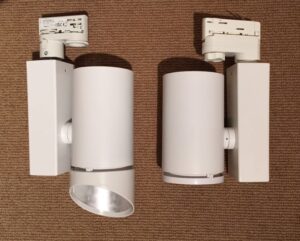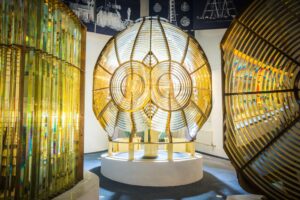Converting Gallery Lighting to LED
Andrew Parkinson, Curator at The Pier Arts Centre explains the process for converting their gallery lighting from halogen lamps/bulbs to LED.

The project
One of the key aims of the project was to reduce carbon emissions whilst retaining as much as possible of the lighting infrastructure. The 2007 refurbishment of the museum established lighting based on ERCO lamps/fixtures and a MODE Lighting control system.
Early research was undertaken by FOTO-MA (Lighting Architects and Designers) to see if our existing lamps were compatible with LED bulbs. While LED technologies are rapidly developing it wasn’t possible to source compatible LED bulbs. However, it’s understood that future developments may make compatible fittings, which will add versatility to our lamp stock.
Almost all fixed electrical structures, including tracks and fixed singlets, were retained avoiding costly and disruptive building and decorative works. The exception was one small gallery which required new lighting units to be fitted due to the very low ceiling with flush lights. LED flush spots were also fitted in the museum shop and meeting room. The museum’s lighting control system (MODE Lighting) was also retained, making good use of this complicated and costly-to-replace element of building infrastructure.

Successes
- One of the most innovative elements of this process was the creation of a hybrid lamp, manufactured by ALFALED using ERCO track adaptors for use in fixed mono points in parts of the museum. This was a cost effective and practical answer to maintaining the lighting singlets.
- An analysis of the first six months operation, comparing electricity used before and after LED installation, shows that a reduction in units of electricity of around 15% has been achieved. It would be hard to apply a cash saving to this percentage as the cost of electricity has increased dramatically, but any reduction in electricity usage is to be welcomed.
- LED dimmable lamps have been precured which automatically dim when not in use i.e. sensors detect movement and return light to pre-programmed levels when someone enters a gallery.
Challenges
- While the outcomes of retaining this infrastructure were very desirable – reducing unnecessary waste/costly works/disruptive and messy installation – it did require innovative thinking on the part of FOTO-MA, MODE Lighting, and the selected lamp suppliers.
Impact
- We’ve reduced our energy consumption.
- The LED lighting system and lamps are not expected to require new bulbs or maintenance within the next twenty years, saving around £10,000 over this period as well as the resulting waste and disposal of consumables.
- LED produces less heat as well as less of the most harmful uv light, which provides better protection for delicate works of art as well as meeting the needs of lending institutions.
- The LED lamps produce a much more attractive ‘white’ light that greatly improves the viewing conditions for visitors in the gallery.
- The gallery lighting complies with UK legislation as halogen bulbs will be banned for sale completely by the end of 2023.
Guidance
- Expert advice was crucial to the success of this project. The specialist technical knowledge supplied by FOTO-MA and other advisers guided the project through some complicated options.
- All the LED lamps acquired have an identical base unit with accessories, including different angles of lenses, snoots and anti-glare lenses available to be fitted as required. This has offered a much simpler and more elegant lighting solution for all the various spaces in the museum.



